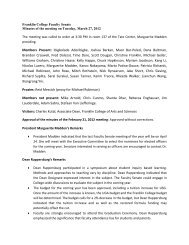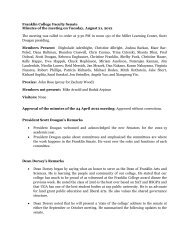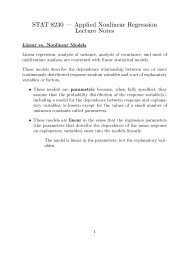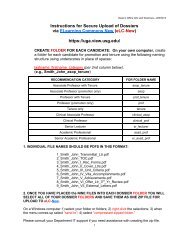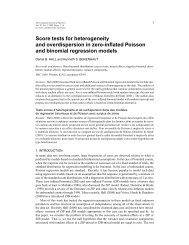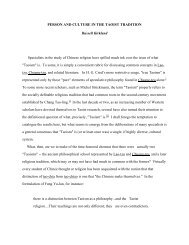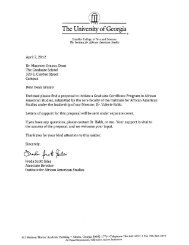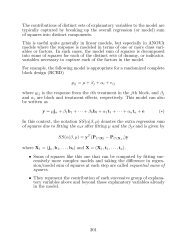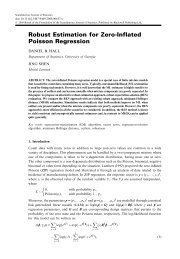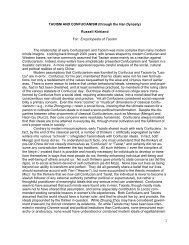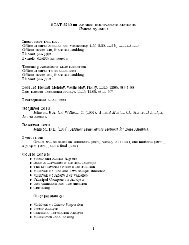Two-component mixtures of generalized linear mixed effects models ...
Two-component mixtures of generalized linear mixed effects models ...
Two-component mixtures of generalized linear mixed effects models ...
You also want an ePaper? Increase the reach of your titles
YUMPU automatically turns print PDFs into web optimized ePapers that Google loves.
26 DB Hall and L Wang<br />
adaptive Gaussian quadrature (AGQ) (Liu and Pierce, 1994; Pinheiro and Bates, 1995).<br />
Let ^b 1 i and ^b 2 i denote the modes <strong>of</strong> the integrands in the numerator and denominator,<br />
respectively, <strong>of</strong> Equation (3.2), and let g 1 (b i ) P n i<br />
j¼1 ‘c (d; y ij ; u (h)<br />
ij<br />
(b i )j<br />
b i )f (y i jb i ; d (h) )f q (b i ) and g 2 (b i ) f (y i jb i ; d (h) )f q (b i ) from equation (3.2). In addition,<br />
let ^G 1i and ^G 2i be the Hessian matrices <strong>of</strong> log g 1 (b i ) and log g 2 (b i ) evaluated at ^b 1 i and<br />
^b 2 i , and let p ‘1 ;...;‘ q<br />
¼ (p ‘1<br />
; ...; p ‘q<br />
) T and z ‘1 ;...;‘ q<br />
¼ (z ‘1<br />
; ...; z ‘q<br />
) T , where p 1 ; ...; p m and<br />
z 1 ; ...; z m are m-point ordinary Gaussian quadrature (OGQ) weights and abscissas,<br />
respectively. Then the quadrature points under AGQ are shifted and rescaled versions<br />
<strong>of</strong> z ‘1 ;...;‘ q<br />
as follows: b 1<br />
i‘ 1 ;...;‘ q<br />
¼ (b 1<br />
i‘ 1<br />
; ...; b 1<br />
i‘ q<br />
) T ¼ ^b 1 i þ 2 q=2 1=2 ^G<br />
1i<br />
z ‘1 ;...;‘ q<br />
and<br />
b 2<br />
i‘ 1 ;...;‘ q<br />
¼ (b 2<br />
i‘ 1<br />
; ...; b 2<br />
i‘ q<br />
) T ¼ ^b 2 i þ 2 q=2 1=2 ^G<br />
2i<br />
z ‘1 ;...;‘ q<br />
for g 1 (b i ) and g 2 (b i ), respectively.<br />
The corresponding AGQ weights are (p ‘ 1<br />
; ...; p ‘ q<br />
) T , where p i ¼ p i exp (z 2 i ).<br />
Hence, at the E step, Q(djd (h) ) is approximated by<br />
X<br />
X m<br />
w (h)<br />
i‘ 1 ;...;‘ q<br />
[u (h)<br />
ij<br />
(b 1<br />
i‘ 1 ;...;‘ q<br />
) log p ij (c) þ {1 u (h)<br />
ij<br />
(b 1<br />
i‘ 1 ;...;‘ q<br />
)} log {1 p ij (c)}]<br />
i;j ‘ 1 ;...;‘ q<br />
n<br />
o<br />
i‘ 1 ;...;‘ q<br />
) log f 1 (y ij jb 1<br />
i‘ 1 ;...;‘ q<br />
; ~a; s 1 )<br />
where<br />
þ Xm<br />
w (h)<br />
i‘ 1 ;...;‘ q<br />
u (h)<br />
ij<br />
(b 1<br />
‘ 1 ;...;‘ q<br />
þ Xm<br />
‘ 1 ;...;‘ q<br />
w (h)<br />
i‘ 1 ;...;‘ q<br />
{1 u (h)<br />
w (h)<br />
i;‘ 1 ;...;‘ q<br />
¼<br />
ij<br />
(b 1<br />
are weights that do not involve d.<br />
3.1.2 M step<br />
n<br />
i‘ 1 ;...;‘ q<br />
)} log f 2 (y ij jb 1<br />
i‘ 1 ;...;‘ q<br />
; b; ~ o <br />
s 2 )<br />
(3:3)<br />
j ^G 1i j 1=2 f (y i jb 1<br />
i‘ 1 ;...;‘ q<br />
; d (h) )f q (b 1<br />
i‘ 1 ;...;‘ q<br />
) Q q<br />
n¼1 p ‘ n<br />
j ^G 2i j 1=2 P h<br />
m<br />
‘ 1 ;...;‘ q<br />
f (y i jb 2<br />
i‘ 1 ;...;‘ q<br />
; d (h) )f q (b 2<br />
i‘ 1 ;...;‘ q<br />
) Q q<br />
n¼1 p ‘ n<br />
In the (h þ 1)th iteration <strong>of</strong> the algorithm, the M step maximizes the approximation to<br />
Q(djd (h) ) given by Equation (3.3) with respect to d. Notice that Q(djd (h) ) has a relatively<br />
simple form that allows it to be maximized in a straightforward way. From Equation<br />
(3.3), the approximation can be seen to be a sum <strong>of</strong> three terms: first, a weighted<br />
binomial loglikelihood involving c only; secondly, a weighted exponential dispersion<br />
family loglikelihood involving only a, h 1 and s 1 ; and thirdly, a weighted exponential<br />
dispersion family loglikelihood involving only b, h 2 , h 3 and s 2 . Therefore, the M step<br />
for d can be done by separately maximizing the three terms in Q(djd (h) ). For each term,<br />
this can be done by fitting a weighted version <strong>of</strong> a standard GLM.<br />
M Step for c. Maximization <strong>of</strong> Q(djd (h) ) with respect to c can be accomplished by<br />
fitting a weighted binomial regression <strong>of</strong> the u (h)<br />
ij<br />
(b 1<br />
i‘ 1 ;...;‘ q<br />
)’s on W i 1 m<br />
q with weights<br />
w (h)<br />
i‘ 1 ;...;‘ q<br />
. Here 1 k is the k 1 vector <strong>of</strong> ones. For instance, for g p taken to be the logit<br />
i



